NEET Biology Notes For Plant Growth And Development Growth
Growth is an irreversible increase in size, volume, and weight of a part or whole of an organism. An irreversible increase in size, volume, or weight is called apparent growth as it is the external manifestation of growth. Formation at cellular materials or protoplasm is the real growth. Growth is a measurable or quantitative phenomenon that can be measured in relation to time. The growth of living beings is internal or intrinsic.
Plant growth is diffused like that of animals only during the early embryonic stages. Later on, plants develop specific areas, called meristem, for growth. On account of meristems, plant growth is localized.
Characteristics Of Plant Growth
- Growth is localized.
- Growth continues throughout life.
- There is an increase in the number of parts.
- It is open-ended.
- The younger one or seedling can be quite different from an adult.
- The juvenile stage may have different traits.
Plant Growth Differentiation: Growth is invariably associated with differentiation. Differentiation is a permanent localized qualitative change in size, biochemistry, structure, and function of cells, tissues, or organs, for example, fiber, vessel, tracheid, sieve tube, mesophyll, leaf, etc. Some examples of differentiation are as follows
- Enlargement, lignocellulosic wall thickening, and emptying in case of tracheids
- Loss of end wall in case of vessel elements
- Loss of nucleus and perforation of end wall in sieve tube members
- Deposition of suberin and tannins in cells
- Differential wall thickening (in guard cells)
- Secretion of mucilage in root cap
Development is the sequence of changes that occur in the structure and functioning of an organism, organ, tissue, or cell involving its formation, growth differentiation, maturation, reproduction, senescence, and death.
Read and Learn More NEET Biology Notes
Characteristics Of Growth
- Primary Growth: It is the formation of primary permanent tissues and organs. It is caused by the activity of apical and intercalary meristems.
- Secondary Growth: It is an increase in girth. It occurs by two types of lateral meristems, vascular cambium and cork cambium.
- Efficiency Index: It is the rate of growth. It is measured by calculating the increase in size, diameter, or area per unit time.
plant growth and development
NEET Biology Notes For Plant Growth And Development Growth Rate
An increase in growth per unit of time is called growth rate. Growth rate may result in arithmetic or geometric growth.
Arithmetic Growth: Arithmetic growth is a type of growth in which the rate of growth is constant and an increase in growth occurs in arithmetic progression 2, 4, 6, 8, 10, and 12. Arithmetic growth is found in root or shoot elongating at a constant rate.
The meristematic cells at the growing point divide in such a fashion that one daughter cell remains meristematic while the other cells grow and differentiate. The process continues. Mathematically, arithmetic growth is expressed as:
Lt = L0 + rt
where Lt is the length after time t, L0 is the length at the beginning, and r is the growth rate or elongation per unit time.
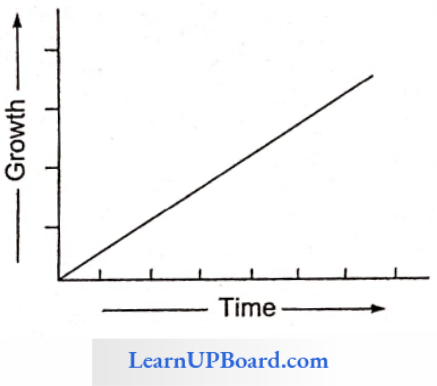
Geometric Growth: Geometric growth is quite common in unicellular organisms when grown in a nutrient-rich medium. Here, every cell divides. The daughter cells grow and divide. The granddaughters repeat the process and so on. The number of cells is initially small so the initial growth is slow. Later on, there is rapid growth at an exponential rate.
Geometric growth cannot be sustained for long. Some cells die. Limited nutrient availability causes a slowing down of growth. It leads to the stationary phase. (There may be actually a decline.) Plotting the growth against time will give a typical sigmoid or S-curve.

The S-curve of growth is typical of most living organisms in their natural environment. It also occurs in cells, tissues, and organs of plants.
Exponential Growth (Law Of Compound Interest): Growth is dependent on three factors: initial size (W0), rate of growth (r), and time interval (t) for which the rate of growth can be retained.
W1 = W0ert
Here W1 is the final size, W0 is the initial size, r is the growth rate, 1 is the time of growth, while e is the base on natural logarithms. The magnitude of r or the rate of growth has been called the efficiency index by Blackman (1919).
Absolute And Relative Growth Rate: Quantitative comparisons between the growths of various systems can be made by measuring their absolute and relative growth rates.
Absolute Growth Rate: The absolute growth curve is the actual growth curve obtained by plotting growth against time. It is commonly S-shaped. The absolute growth rate is the total growth per unit time. A graph plotted for absolute growth rates for various times of the grand period of growth appears bell-shaped.
” plant growth and development short notes”
The peak is formed when the growth rate is the fastest. The period of increasing growth is depicted by the first part of the curve while the period of decreasing growth rate is shown by the second part of the curve.
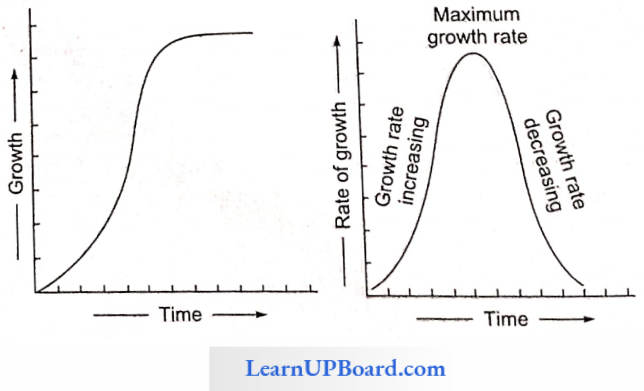
Relative Growth Rate: It is the growth per unit time per unit initial growth.
Relative growth rate = \(\frac{\text{Growth in given time period}}{\text{Measurement at start of time period}}\)
Suppose two leaves have grown by 5 cm² in one day. The initial size of leaf A was 10 cm² while that of leaf B was 15 cm². Though their absolute growth is the same, the relative rate of growth is faster in leaf A.
NEET Biology Notes For Plant Growth And Development Measurement Of Growth
To measure growth, various methods/instruments are used.
- Direct method
- Horizontal microscope
- Auxanometer
- Arc auxanometer
- Pfeffer’s auxanometer
- Crescograph (Developed By J.C. Bose): A highly sensitive growth-measuring instrument that can magnify growth by 10000 times.
NEET Biology Notes For Plant Growth And Development Growth Hormones
In all plants, minute quantities of certain substances are found (plant growth regulators or phytohormones), which regulate growth and differentiation.
Five major types of growth substances are recognized: aux-ins, gibberellins, cytokinins, abscisic acid, and ethylene.
Auxins: Auxins are weak organic acids having unsaturated ring structures.
- Charles Darwin conducted his experiments concerning growth on canary grass (Phalaris canariensis) and found that the bending movement of coleoptiles in uni-lateral light was due to a chemical.
- Went is credited with the discovery of auxin.
- Auxins are synthesized mainly in apices and exhibit polar transport through parenchyma.
- KogI and Haagen Smith (1931) found that human urine contained a growth substance, which was isolated and given the name auxin-a (auxentriolic acid). In 1934, Kogl and coworkers isolated another compound, auxin-b (auxenolinic acid) from com germ oil and heteroauxin (now known as IAA or indole-3-acetic acid, C10H9O2N), from human urine. It is the only natural auxin.
- The precursor of auxin is the tryptophan amino acid.
- The optimum concentration in the stem apex is 10 ppm while in the root apex, it is 0.0001 ppm.
- Auxin is active in a free state and can be easily extracted. Bound auxin is inactive and meant for storage. For example, IAA-aspartic acid, IAA-inositol, and IBA-alanine.
Functions Of Auxins
- Auxins promote cell elongation by loosening cell wall microfibrils, solubilization of carbohydrate reserve, and increased respiration.
- Responsible for phototropism and geotropism.
- Promote apical dominance (in the presence of an apical bud, the growth of lateral buds are inhibited due to auxin secreted by the apical bud).
- Promote root initiation in cuttings (by NAA, IBA).
- Delay of abscission of leaves by preventing the formation of an abscission layer.
- Prevention of lodging in cereals.
- Induce parthenocarpy (production of seedless fruits).
- Selective weedicide.
- Have feminizing effect (increase number of female flowers in plants, for example, Cannabis).
- Seasonal activity of cambium is promoted by auxin.
- Healing of injury is effected through auxin-induced division in cells around the injured area.
- Auxin induces negative potential in cell membranes.
- In legumes, IAA stimulates nodule formation.
Antiauxins: They inhibit auxin activity. For example, triiodobenzoic acid (TIBA), PCIB (p-chlorophenoxy isobutyric acid)
Bioassay Of Auxins
- Avena curvature test
- Split pea test
- Root growth inhibition test
Applications Of Synthetic Auxins
- Rooting: IBA, IBA-alanine, and NAA are used.
- Parthenocarpy: IAA, IBA.
- Weedicide: 2,4-D, 2,4-5-T are used for killing broad-leaved weeds (generally dicot).
- Flowering: NAA and 2,4-D for litchi and pineapple.
- Storage: Methyl ester of NAA for the storage of potato.
- Pre-harvest Fruit Drop: 2,4-D for citrus fruits; NAA for tomato.
- Prevention Of Lodging: Naphthalene acetamide (NAAM).
- Vegetable Crops: Chlorophenoxypropionic acid is used to improve the quality of vegetable crops by inhibiting flower formation. For example, lettuce.
Dwarf Shoots: NAA is used for increasing dwarf shoots and a number of fruits in apples.
Gibberellins: In the early twentieth century, Japanese farmers noticed balance or foolish seedling disease of lice. As a result of the disease, certain rice seedlings grew excessively tall, the disease was caused by the fungus Gibherella fuikuroi (perfect state of Fusarium moniliform).
ch 15 biology class 11 notes
- Yabuta and Suxniki (1930) isolated the growth-inducing hormone and called it gibberellin.
- Chemically, all gibberellins are terpenes, a complex group of plant chemicals related to lipids. All are weak acids and have gibbane ring skeletons. GA3 is the commonest. GA24 and GA25 are found only in fungi. The precursor is acetyl CoA.
- Gibberellins are synthesized in the apices of young leaves, embryos, buds, and roots and are transported through the xylem.
Applications Of Gibberellins
- Internodal Elongation: Like auxins, the main effect of gibberellins is on stem elongation. Gibberellins stimulate stem elongation and leaf expansion but do not affect roots. Thus, gibberellins restore normal-size arid growth to genetically dwarf varieties of pear and maize.
- Bolting: In many plants, leaf development is profuse, while internodal growth is retarded. This term of growth is called rosette, for example, cabbage, radish, and henbane. Just before the reproductive phase, internodes elongate enormously, causing a marked increase in height.
The stem sometimes elongates five to six times the original height of the plant. This is called bolting. Bolting requires either long days or cold nights and gibberellins treatment.
- Germination Of Seeds: Gibberellins promote seed germination (especially in cereals).
- Control Of Flowering: Gibberellins promote flowering in long-day plants and inhibit it in short-day plants. These also control sex expression in certain species. In general, the application of gibberellins promotes the production of male flowers in female plants of Cannabis.
- Control Of Fruit Growth: Along with gibberellins, auxins control fruit growth and development. Gibberellins cause parthenocarpy in pome fruits (apple, pear, etc.).
- Vernalization: Gibberellins can substitute vernalization.
- Dormancy: Gibberellins overcome the natural dormancy of buds, tubers, seeds, etc.
Commercial Application Of Gibberellins
- Fruit Growth: Increase the number and size of grapes, tomatoes, etc. Pomalin (a mixture of GA3 and BAP) is used for such purpose.
- Malt: Increase the yield of malt from barley.
- Overcoming Dormancy: In photoelastic seeds of tobacco and lettuce
- Delay Ripening: in citrus.
- Induce Flowering: In long-day plants, in non-inductive periods.
Antigibberellins: Certain chemicals are antagonistic to gibberellins. For example, Phosphan-D, Amo-1618, CCC, and maleic hydrazide.
Bioassay Of Gibberellins
- Induction of α-amylase in barley endosperm test
- Dwarf maize test
- Dwarf pea test
Cytokinins: They are basic hormones and are purine (adenine) derivatives. Cytokinins are substances that act primarily on cell division and have little or no effect on extension growth. In 1955, Miller et al. separated it from herring sperm DNA and yeast DNA and called it kinetin (because of its involvement in cell division, i.e., cytokinesis). Later on, the substance was identified as 6-furfuryl aminopurine. Subsequently, the term cytokinin was adopted by Letham.
- The first naturally occurring cytokinin to be chemically identified was from young maize (Zea mays) grains in 1963 and was called zeatin, which is benzyl amino purine (BAP). Cytokinins are a part of t-RNA.
- Cytokinins are mostly synthesized in roots, seeds, and developing fruits. Coconut milk and apple fruit extracts are rich in cytokinins. Some other cytokinins are dihydrozeatin, IPA (isopentanyl adenine).
Applications Of Cytokinins
- Cell-division: Cytokinins are quite abundant wherever rapid cell division occurs, especially in growing tissues.
- Morphogenesis: Cytokinins promote cell division. In the presence of auxins, cytokinins promote cell division even in non-meristematic tissues. In tissue cultures, mitotic divisions are accelerated when both auxin and cytokinin are present. The ratio of cytokinins to auxins also controls cell differentiation and morphogenesis.
- Apical Dominance: Cytokinins and auxins act antagonistically in the control of apical dominance.
- Delay In Senescence: Cytokinins delay the senescence of plant organs by controlling protein synthesis and mobilization of resources. This is called the Richmond-Lang effect. Cytokinins are also called anti-aging hormones.
- Flowering: Cytokinins also induce flowering in certain species of plants such as Lemna and Wolffia and are also responsible for breaking the dormancy of seeds of some plants.
- Favors Transport: Phloem transport is promoted.
- Favors Salt Accumulation: Accumulation of salts in the cells is promoted.
- Favors Sex-Expression: Promote femaleness.
- Temperature/disease Resistance: Increase resistance to low and high temperatures and diseases.
Commercial Applications of Cytokinins
- Tissue culture
- The shelf life of vegetables and cut flowers is increased
- Overcoming senescence
Bioassay Of Cytokinins
- Chlorophyll preservation test.
- Cell division test
“plant growth “
Ethylene: Ethylene is the only natural plant growth regulator in gaseous form and is effective in the concentration of 0.01-10 ppm.
Ethylene is produced by most or all plant organs but maximum production occurs in ripening fruits and during senescence. High concentrations of auxin induce the formation of ethylene. Though it is a gas, it does not generally move through air spaces in plants. Rather, it escapes from the plant surface. The precursor of ethylene is methionine.
Applications Of Ethylene
- Growth: Ethylene inhibits stem elongation and stimulates its transverse expansion. As a result, the stem looks swollen.
- Abscission: It accelerates the abscission of leaves, flowers, and fruits.
- Fruit Ripening: Its chief effects are on the ripening of fruits accompanied by a rise in the rate of respiration (climacteric). It causes the dehiscence of dry fruits.
- Flowering: The application of ethylene induces flowering in pineapple.
- A commercial compound “ethephon” breaks down to release ethylene in plants. It is particularly applied to rubber plants for the flow of latex.
- It decreases the sensitivity to gravity. Roots become apogeotropic; seedling develops a tight epicotyl hook.
- It has a feminizing effect.
- Bioassay: Triple response test.
Growth Inhibitors
- For a long time, it has been suspected that dormancy is caused by inhibitors. A group of scientists led by Wareing initiated studies to find them. In 1964, pure crystals of a substance were isolated called dormin. It was found to be similar to another compound isolated from young cotton fruits in 1963 by Addicott.
- This substance accelerated abscission and was called abscission 2. In 1967, it was decided to call it abscissic acid (ABA). Since then, it has been found in all groups of plants (from mosses to higher plants). In liverworts and algae, a compound lunular acid has been found to have activities similar to ABA.
- Chemically, ABA is a dextrorotatory cA-sesquiterpene. ABA is synthesized in leaves and transported through the xylem and phloem. It is a major inhibitor of growth in plants and is antagonistic to all three growth promoters. Its precursor is violaxanthin (in chloroplast).
Applications Of ABA
- Stoppage Of Cambial Activity: It inhibits mitosis in vascular cambium.
- Bud Dormancy: It induces axillary buds to become dormant as the winter approaches.
- It plays a role in seed development, maturation, and dormancy.
- Transpiration: It is a “stress hormone” and helps the plant to cope with adverse environmental conditions by closing stomata (antitranspirant).
- It may be sprayed on tree crops to regulate fruit drop at the end of the season.
- Application of ABA to green oranges turns them yellow by inducing the synthesis of carotenoids.
- It induces flowering in some short-day plants such as strawberries and blackcurrant.
NEET Biology Notes For Plant Growth And Development Dormancy
In favorable conditions, if a viable seed fails to germinate, this condition is called dormancy and if the viable seed fails to germinate due to unfavorable conditions, it is called “quiescence.” Dormancy may be due to:
- Seed coat impermeable to gases, for example, apple, or water, for example, Trigonella; or seed coat mechanically resistant, for example, Capsella, Amaranthus.
- Immaturity of the embryo, for example, G. biloba.
- Specific light requirement: Some seeds require light for germination and are called positive photoblastic seeds (for example, Lactuca sativa, Nicotiana tobaccum, Lythrum, etc.). Lettuce (Lactuca) is induced by red light and inhibited by far red light. Some seeds show inhibition in germination due to light exposure and are called negative photoblastic, for example, onions, lily, phlox, etc.
- Dormancy due to chilling temperature requirement, for example, Polygonum.
- After-ripening: Some seeds have a mature embryo but do not germinate immediately due to the absence of growth hormone. They require a period of after-ripening during which they attain the power to germinate. For example, oats, barley, wheat, etc.
- Due To Germination Inhibitors: Some chemicals such as organic acids, phenolics, tannins, alkaloids, lactones, mustard oil, etc., inhibit germination (for example, ferulic acid in tomato pulp).
“plant growth and development neetprep “
Methods To Break Dormancy
- Scarification: It is a method of softening and weakening of seed coat by acids, alcohol, or knife.
- Stratification: After ripening treatment, low temperature (0-10°C) with O2.
- Light exposure.
- Low temperature + Gibbcrellin + O2 treatment, etc.
NEET Biology Notes For Plant Growth And Development Seed Germination
Seed germination is of two types:
- Epigeal: Hypocotyl grows first, cotyledons come out of the soil as in cucurbits, mustard, castor, onion, tamarind, etc.
- Hypodeal: Epicotyl grows first, cotyledons remain underground as in rice, maize, mango, Fabaceae, etc. Whenever a seed germinates inside the fruit, it is vivipary as in Rhizophora, Sonneralia, and Heritiera (mangrove plants).
NEET Biology Notes For Plant Growth And Development Cytochrome
Borthwick and Hendrick, in the 1950s, plotted the action spectrum of wavelengths showing their relative effectiveness in stimu¬lating seed germination. The wavelength most effective for promoting germination was 660 nm (red) and for inhibition of germination about 730 nm (far red). They also demonstrated that only brief exposures of light were necessary and that the effects of red light were reversed by far red fight and vice versa.
- The pigment responsible for this was isolated in 1960 and was called phytochrome by Butler. It is a blue-green pigment existing in two interconvertible forms: PFR or P730 (absorbs far-red lights) and PR or P660 (absorbs red light).
- By absorbing red light, PR is converted to PFR rapidly. PFR absorbing far-red light is converted to PR rapidly. PFR is the physiologically active form; PR is inactive. The table describes the effects of red light and far red light on plant growth.

Effects Of Red Light And Far Red Light On Plant Growth
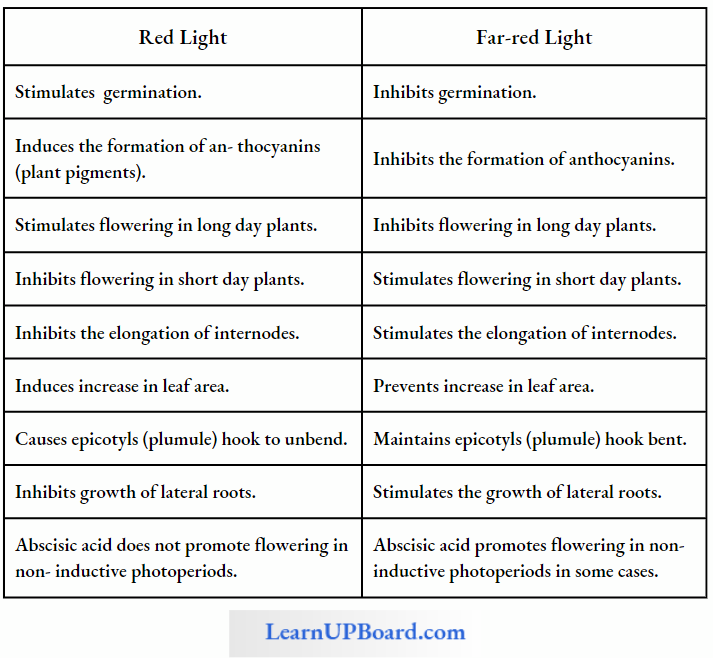
Phytochrome is responsible for various photomorphogenic processes in plants such as the growth and development of plant organs; germination of seed, pollen, and spores; flowering; differentiation of stomata; epinasty and abscission; etc.
NEET Biology Notes For Plant Growth And Development Photoperiiqdiibm
The response of plants to changes in the relative lengths of day and night is called photoperiodism.
Photoperiod: The relative lengths of dark and light periods in a day vary from place to place and from season to season. The length of the light period is called the photoperiod. At equators, the day length is of 12 hours duration throughout the year.
Types Of Plants According To Photoperiodic Requirements For Flowering
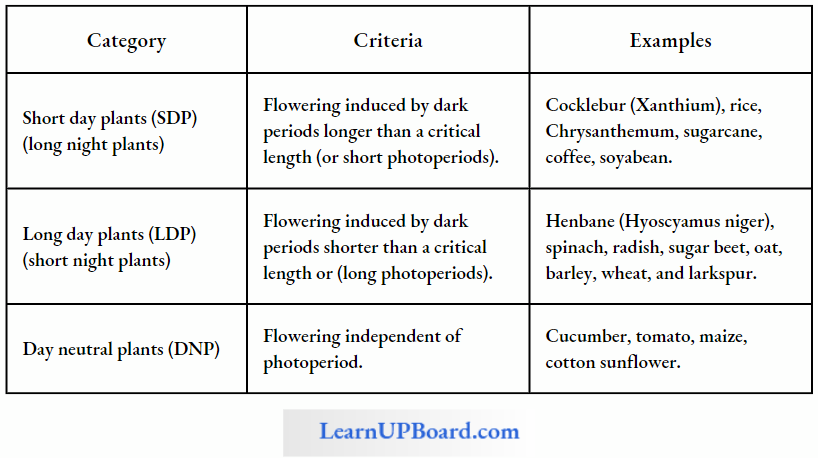
For SDP, PR/PFR > 1 while for LDP, PFR/PR > 1 is critical for flowering.
Photoperiodic stimulus is perceived by the leaf. When proper photoperiod is perceived, a flowering hormone called florigen is synthesized in the leaf and is transported to the bud where flowering occurs. Florigen, a hypothetical hormone, is chemically similar to gibberellins.
Difference Between Long-Day And Short-Day Plants
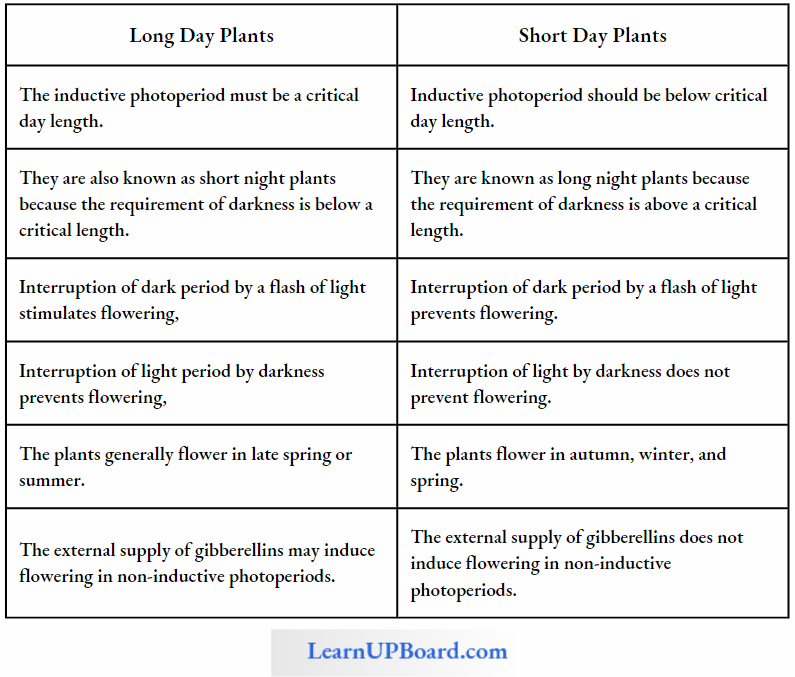
NEET Biology Notes For Plant Growth And Development Vernalization (Yarovization)
The term vernalization was coined by the Russian agronomist Lysenko to refer to the method of accelerating the flowering ability of biennials or winter annuals, by exposing their soaked seeds to low temperatures for a few weeks.
- However, presently the term is used in a wider sense to include the promotion of flowering in plants by exposing them to low temperatures at any stage in their life cycle. It has been found that some plants especially biennials and perennials are stimulated to flower by exposure to low temperatures.
- This promotive effect of temperature on flowering is called vernalization. The vernalization was first studied in Europe on the winter varieties of cereals such as wheat, barley, oats, and rye by Klippart.
Site Of Vernalization: The sites of vernalization are the shoot tip, embryo tip, and root apex. As a result of vernalization, a hormone called vemalin (by Melcher) is synthesized.
Requirements Of Vernalization
- Low temperature: 0°C-5°C
- Period of low temperature: A few hours to a few days
- Actively dividing cells (meristematic cells)
- Water
- Aerobic condition
- Proper nourishment
As a result of vernalization, the vegetative phase of the plant is shortened and flowering is initiated. Therefore, the duration of crops is reduced.
NEET Biology Notes For Plant Growth And Development Senescence
Senescence is the study of aging in plants. It is of the following types:
Sequential Senescence: In many perennial plants, the apical meristems continue to produce new buds and leaves, while the older leaves and lateral organs undergo senescence and die. For example, Eucalyptus, mango.
Shoot Senescence: In some perennials such as banana and Gladiolus, the aboveground part of the shoot dies every year after producing flowers and fruits. However, the underground parts survive and give rise to new shoots again in the following year.
Simultaneous Or Synchronous Senescence: In some trees such as elm, Dalbergia, and maples, all the leaves are shed in late autumn (October).
Whole Plant Senescence: In monocarpic plants that flower and produce fruits only once in life, for example, wheat, rice, mustard, etc.
NEET Biology Notes For Plant Growth And Development Abscission
It is a natural separation or shedding of leaves, foliage branches, fruits, floral parts, etc., from plants. It is generally seasonal. A special narrow zone develops in the area of abscission called as abscission zone. Two distinct layers develop in the abscission zone:
- Separation layer (upper layer) and
- Protective layer (lower suberized and lignitized layer).
NEET Biology Notes For Plant Growth And Development Points To Remember
Strasburger studied growth in roots by marking it at equal intervals with Indian ink.
- Ethylene causes respiratory climacteric.
- The most widely occurring cytokinin in plants is isopentenyl adenine (IPA).
- Sleep disease (enrolling of petals in opened flowers) is caused by ethylene. Even 1 ppm of ethylene prevents the opening of flower buds.
- Zinc is important for auxin synthesis.
- Clinostat is an instrument used for eliminating the effect of gravity.
- Phytochrome is a regulatory pigment. It regulates several light-dependent developmental processes in it called photomorphogenetic processes.
- Ethylene is the most widely used plant growth regulator in agriculture.
NEET Biology Notes For Plant Growth And Development Assertion Reasoning Questions And Answers
In the following questions, an Assertion (A) is followed by a corresponding Reason (R). Mark the correct answer.
- If both Assertion and Reason are true and the Reason is the correct explanation of the Assertion.
- If both Assertion and Reason are true, but the Reason is not the correct explanation of the Assertion.
- If Assertion is true, but Reason is false.
- If both Assertion and Reason are false.
Question 1. Assertion: If a plant is kept horizontally, auxin accumulates on the lower surface.
Reason: The displacement of statoliths and other cell organelles to lower surfaces modifies the translocation pattern of auxins.
Answer: 1. If both Assertion and Reason are true and the Rea¬son is the correct explanation of the Assertion.
Question 2. Assertion: Only bud and embryo can be vernalized.
Reason: Vernalization requires dividing cells.
Answer: 3. If Assertion is true, but Reason is false.
Question 3. Assertion: Phytochrome, a protein, has regulatory functions.
Reason: Various morphogenetic processes are regulated by it.
Answer: 2. If both Assertion and Reason are true, but the Reason is not the correct explanation of the Assertion.
Question 4. Assertion: Auxin treatment causes acidification of the cell wall and helps in cell elongation.
Reason: Loosening of cell wall microfibrils occurs.
Answer: 1. If both Assertion and Reason are true and the Reason is the correct explanation of the Assertion.
Question 5. Assertion: Cytokinins are anti-aging hormones.
Reason: They cause changes in osmotic potential by increasing the volume of mature cells.
Answer: 4. If both Assertion and Reason are false.
